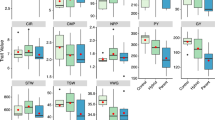Abstract
The extent and pattern of variation were studied in the seven crosses of F1 population of improved S. officinarum x Interspecific hybrids of Saccharum involving one cultivated S. barberi and two wild species S. spontaneum and S. robustum. The study revealed the superiority of all the crosses for cane population and presence of substantial variability for further effective selection and utilization. In general the hybrid progenies were observed to be thin. High heterotic vigour was observed for cane height, which will be of use to maintain yield potential. Mean performance of the crosses for H.R. Brix% was low, which needs further improvement. The average NMC in crosses in general were less when compared to male parent ISH 154 and were high in comparison with pistil parent like Co 87010. The crosses involving commercial hybrids as a pistil parent and S.robustum as a donar in the male parent namely Co 87010 X ISH 29 was superior for single cane weight and cane yield. There was an improvement in cane diameter and H.R. Brix % by utilizing clone ISH 29 from S. robustum group as a male parent, whereas, S. barberi involving clone ISH 154 helps in increasing the cane population and millable cane height in respective crosses. In general, clones with high number of millable canes, moderate brix, good vigour and medium thick canes were also observed which can be exploited further.
Similar content being viewed by others
References
Arceneaux A (1965). Cultivated sugarcane of the world and their botanical derivation. Proc. ISSCT 12: 844–854.
Babu CN, Ethirajan AS (1962). A note on use of S. spontaneum L. in sugarcane breeding. Proc. ISSCT 11: 464–469.
Dunckelman TH, Breaux RD (1971). Breeding of sugarcane varieties for Louisiana with new germplasm. Proc. ISSCT XIV, pp 233–239.
Hawkes JG (1977). The importance of wild germplasm in Plant Breeding. Euphytica, 26: 615–621.
Price S (1963) Cytogenetics of modern sugarcane. Economic Botany, 17: 97–106.
Roach BT (1968). Quantitative effects of hybridization in S. officinarum x S. spontaneum crosses. Proc. ISSCT 13: 939–954.
Roach BT (1977). Utilization of S. spontaneum in sugarcane breeding. Proc. ISSCT 16: 43–57.
Shang KC, Jaung PY, Chu TL, Huang ST (1968). A study on transmission of some important characteristics of Taiwan originated wild cane (S. spontaneum L.). Proc. ISSCT 13: 968–974.
Stevenson GC (1965). Genetics and Breeding of sugarcane. Longman, London UK.
Walker DIT (1971). Utilization of noble and S. spontaneum germplasm in the West Indies. Proc. ISSCT 14: 224–232.
Author information
Authors and Affiliations
Corresponding author
Rights and permissions
About this article
Cite this article
Hapase, R.S., Sushir, K.V., Hapase, P.R. et al. Studies on variation in interspecific hybrids of Saccharum . Sugar Tech 12, 155–159 (2010). https://doi.org/10.1007/s12355-010-0030-8
Received:
Revised:
Accepted:
Published:
Issue Date:
DOI: https://doi.org/10.1007/s12355-010-0030-8




